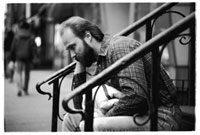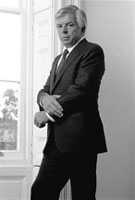Technology Marches On
But The Simple Power Of Black And White Endures
Over the past few years,
I've covered more and more digital imaging technology, as it completes
its total worldwide domination of the professional photography marketplace.
Like a lot of you, I still maintain a full black and white darkroom,
and the smell of stop bath and fixer is the smell of photography. For
us old-school guys, there is little to challenge the depth and power
of the black and white portrait. |
|||
Lighting.
As with any photograph, the light source defines the image. As you can
see in Photo 1, dramatic lighting can be particularly effective in black
and white. For this corporate headshot, I went with a stark "Meet
The Beatles" look by placing a Chimera medium softbox to the right
of the subject, lighting only one half of his face. To keep light from
streaming into my lens I hung a large black gobo between the light and
the camera. To keep some tone in the background I aimed a flash head with
a silver reflector at the floor behind the subject, allowing enough light
to spill up and give the wall some tone. |
|||
Perspective Matters.
With black and white more than color film you need to choose the right
perspective. Black and white reveals certain elements of form that are
often masked by the normal colors we see on a daily basis. While the quality,
quantity, and direction of the prevailing light source will do most of
the work in defining the look and feel of your image, the perspective
you choose can add a lot. I always choose an eye level or above camera
position for standard portraits and modeling shots, but I tend to get
more adventurous when shooting black and white. Why? Because when color
information is lacking, your eye is just more naturally drawn to the subtle
details and lines that might otherwise get lost. For this shot (Photo
3) the model chose a heavy weight sweater that had an interesting pattern.
To keep the sweater a prominent feature, I lowered my camera angle. In
fact, I was just about laying down on the floor to get this shot. |
|||
Moody Black And White.
For this gritty urban street scene (Photo 4) shot for a magazine assignment
we needed to convey a sense of desperation. While the rest of the piece
was shot on vibrant Fuji Velvia, I shot this series on old-fashioned Kodak
Tri-X film developed in Agfa Rodinal 1:25. To keep the reportage feel,
I shot everything very tight with long lenses. I think that this shot
was done with a 300mm lens bolted to a heavy-duty tripod. I resisted the
urge to punch up the scene with some fill flash, and I even waited for
a wispy cloud to pass overhead to create a duller mood. |
|||
Adding Light. Here's
a typical black and white assignment. A corporate executive at a window,
(Photo 5) lit in the foreground with flash. The whole idea here is to
create a scene that looks real, not fake. In order to create a real sense
of reality of course I have to fake it anyway. I added a silver reflector
card to bounce back some of the window light as well as a 2400 ws flash
in a large softbox. By adding plenty of flash punch I can stop the lens
way down, keeping the window frame sharp and reducing the flare that a
bright window light might have caused wide open. |






































